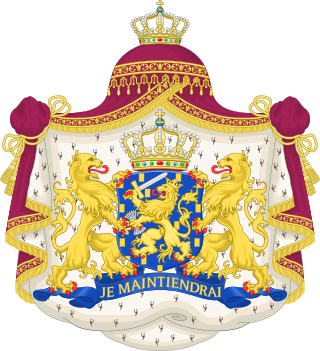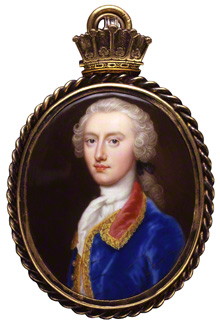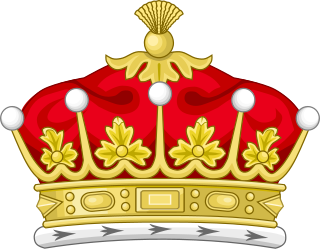
Earl of Rochford was a title in the Peerage of England. It was created in 1695 and became extinct in 1830.

Earl of Rochford was a title in the Peerage of England. It was created in 1695 and became extinct in 1830.
The title of Earl of Rochford was created in 1695 for William Nassau de Zuylestein, one of the most trusted companions of his kinsman, William of Orange. He was made Viscount Tunbridge at the same time, also in the Peerage of England. He was the son of Frederick Nassau de Zuylestein, natural son of Frederick Henry, Prince of Orange. Zuylestein was sent to England in 1687 and again in 1688 to report on the condition of affairs. In 1688 he sailed with the prince on his famous expedition. After the Revolution he was naturalized and served the king in the field, being raised to the English peerage in 1695. He was succeeded by his son William, the second Earl, who was killed at the Battle of Almenar, and then by another son, Frederick, the third Earl. Frederick's son, William Henry, the 4th Earl, was a diplomat and a statesman. Having gained experience as envoy at Turin from 1749 to 1753, he was Ambassador to Madrid from 1763 to 1766 and to Paris from 1766 to 1768. From 1768 to 1775 he was one of the secretaries of state. He left no legitimate children when he died on 28 September 1781, and was succeeded by his nephew, William Henry, the 5th Earl. [1] The titles became extinct on the latter's death in September 1830. The estates of the Earls of Rochford were in Suffolk and Essex, their principal residence being St Osyth Priory in the latter county. [2]
The earls of Rochford used the arms below, inherited via the founder of their Family Fredrick of Nassau, lord of Zuylestein, illegitimate son of Frederick Henry, Prince of Orange.
| Family tree of the House of Nassau-Zuylestein | |||||||||||||||||||||||||||||||||||||||||||||||||||||||||||||||||||||||||||||||||||||||||||||||||||||||||||||||||||||||||||||||||||||||||||||||||||||||||||||||||||||||||||||||||||||||||||||||||||||||||||||||||||||||||||||||||||||||||||||||||||||||||||||||||||||||||||||||||||||||||||||||||||||||||||||||||||||||||||||||||||||||||||||||||||||||||||||||||||||||||||||||||||||||||||||||||||||||||||||||||||||||||||||||||||||||||||||||||||||||||||||||||||||||||||||||||||||||||||||||||||||||||||||||||||||||||||||||||||||||||||||||||||||||||||||||||||||||||||||||||||||||||||||||||||||||||||||||||||||||||||||||||||||||||||||||||||||||||||||||||||||||||||||||||||||||||||||||||||||||||||||||||||||||||||||||||||||||||||||||||||||||||||||||||||||||||||||||||||||||||||||||||||||||||||||||||||||||||||||||||||||||||||||||||||||||||||||||||||||||||||||||||||||||||||||||||||||||||||||||||||||||||||||||||||||||||||||||||||||||||||||||||||||||||||||||||||||||||||||||||||||||||||||||||||||||||||||||||||||||
|---|---|---|---|---|---|---|---|---|---|---|---|---|---|---|---|---|---|---|---|---|---|---|---|---|---|---|---|---|---|---|---|---|---|---|---|---|---|---|---|---|---|---|---|---|---|---|---|---|---|---|---|---|---|---|---|---|---|---|---|---|---|---|---|---|---|---|---|---|---|---|---|---|---|---|---|---|---|---|---|---|---|---|---|---|---|---|---|---|---|---|---|---|---|---|---|---|---|---|---|---|---|---|---|---|---|---|---|---|---|---|---|---|---|---|---|---|---|---|---|---|---|---|---|---|---|---|---|---|---|---|---|---|---|---|---|---|---|---|---|---|---|---|---|---|---|---|---|---|---|---|---|---|---|---|---|---|---|---|---|---|---|---|---|---|---|---|---|---|---|---|---|---|---|---|---|---|---|---|---|---|---|---|---|---|---|---|---|---|---|---|---|---|---|---|---|---|---|---|---|---|---|---|---|---|---|---|---|---|---|---|---|---|---|---|---|---|---|---|---|---|---|---|---|---|---|---|---|---|---|---|---|---|---|---|---|---|---|---|---|---|---|---|---|---|---|---|---|---|---|---|---|---|---|---|---|---|---|---|---|---|---|---|---|---|---|---|---|---|---|---|---|---|---|---|---|---|---|---|---|---|---|---|---|---|---|---|---|---|---|---|---|---|---|---|---|---|---|---|---|---|---|---|---|---|---|---|---|---|---|---|---|---|---|---|---|---|---|---|---|---|---|---|---|---|---|---|---|---|---|---|---|---|---|---|---|---|---|---|---|---|---|---|---|---|---|---|---|---|---|---|---|---|---|---|---|---|---|---|---|---|---|---|---|---|---|---|---|---|---|---|---|---|---|---|---|---|---|---|---|---|---|---|---|---|---|---|---|---|---|---|---|---|---|---|---|---|---|---|---|---|---|---|---|---|---|---|---|---|---|---|---|---|---|---|---|---|---|---|---|---|---|---|---|---|---|---|---|---|---|---|---|---|---|---|---|---|---|---|---|---|---|---|---|---|---|---|---|---|---|---|---|---|---|---|---|---|---|---|---|---|---|---|---|---|---|---|---|---|---|---|---|---|---|---|---|---|---|---|---|---|---|---|---|---|---|---|---|---|---|---|---|---|---|---|---|---|---|---|---|---|---|---|---|---|---|---|---|---|---|---|---|---|---|---|---|---|---|---|---|---|---|---|---|---|---|---|---|---|---|---|---|---|---|---|---|---|---|---|---|---|---|---|---|---|---|---|---|---|---|---|---|---|---|---|---|---|---|---|---|---|---|---|---|---|---|---|---|---|---|---|---|---|---|---|---|---|---|---|---|---|---|---|---|---|---|---|---|---|---|---|---|---|---|---|---|---|---|---|---|---|---|---|---|---|---|---|---|---|---|---|---|---|---|---|---|---|---|---|---|---|---|---|---|---|---|---|---|---|---|---|---|---|---|---|---|---|---|---|---|---|---|---|---|---|---|---|---|---|---|---|---|---|---|---|---|---|---|---|---|---|---|---|---|---|---|---|---|---|---|---|---|---|---|---|---|---|---|---|---|---|---|---|---|---|---|---|---|---|---|---|---|---|---|---|---|---|---|---|---|---|---|---|---|---|---|---|---|---|---|---|---|---|---|---|---|---|---|---|---|---|---|---|---|---|---|---|---|---|---|---|---|---|---|---|---|---|---|---|---|---|---|---|---|---|---|---|---|---|---|---|---|---|---|---|---|---|---|---|---|---|---|---|---|---|---|---|---|---|---|---|---|---|---|---|---|---|---|---|---|---|---|---|---|---|---|---|---|---|---|---|---|---|---|---|---|---|---|---|---|---|---|---|---|---|---|---|---|---|---|---|---|---|---|---|---|---|---|---|---|---|---|---|---|---|---|---|---|---|---|---|---|---|---|---|---|---|---|---|---|---|---|---|---|---|---|---|---|---|---|---|---|---|---|---|---|---|---|---|---|---|---|---|---|---|---|---|---|---|---|---|---|---|---|---|---|---|---|---|---|---|---|---|---|---|---|---|---|---|---|---|---|---|---|---|---|---|---|---|---|---|---|---|---|---|---|---|---|---|---|---|---|---|---|---|---|---|---|---|---|---|---|---|---|---|---|---|---|---|---|---|---|---|---|---|---|---|---|---|---|---|---|---|---|---|---|---|---|---|---|---|---|---|---|---|---|---|---|---|---|---|---|---|---|---|---|---|---|---|---|---|---|---|---|---|---|---|---|---|---|---|---|---|---|---|---|---|---|---|---|---|---|---|---|---|---|---|---|---|---|
| |||||||||||||||||||||||||||||||||||||||||||||||||||||||||||||||||||||||||||||||||||||||||||||||||||||||||||||||||||||||||||||||||||||||||||||||||||||||||||||||||||||||||||||||||||||||||||||||||||||||||||||||||||||||||||||||||||||||||||||||||||||||||||||||||||||||||||||||||||||||||||||||||||||||||||||||||||||||||||||||||||||||||||||||||||||||||||||||||||||||||||||||||||||||||||||||||||||||||||||||||||||||||||||||||||||||||||||||||||||||||||||||||||||||||||||||||||||||||||||||||||||||||||||||||||||||||||||||||||||||||||||||||||||||||||||||||||||||||||||||||||||||||||||||||||||||||||||||||||||||||||||||||||||||||||||||||||||||||||||||||||||||||||||||||||||||||||||||||||||||||||||||||||||||||||||||||||||||||||||||||||||||||||||||||||||||||||||||||||||||||||||||||||||||||||||||||||||||||||||||||||||||||||||||||||||||||||||||||||||||||||||||||||||||||||||||||||||||||||||||||||||||||||||||||||||||||||||||||||||||||||||||||||||||||||||||||||||||||||||||||||||||||||||||||||||||||||||||||||||||

The House of Orange-Nassau is the current reigning house of the Netherlands. A branch of the European House of Nassau, the house has played a central role in the politics and government of the Netherlands and elsewhere in Europe, particularly since William the Silent organised the Dutch Revolt against Spanish rule, which after the Eighty Years' War (1568–1648) led to an independent Dutch state. William III of Orange led the resistance of the Netherlands and Europe to Louis XIV of France and orchestrated the Glorious Revolution in England that established parliamentary rule. Similarly, Queen Wilhelmina of the Netherlands was instrumental in the Dutch resistance during World War II.

Frederick Henry was the sovereign prince of Orange and stadtholder of Holland, Zeeland, Utrecht, Guelders, and Overijssel in the Dutch Republic from his older half-brother's death on 23 April 1625 until his death on 14 March 1647. In the last seven years of his life, he was also the stadtholder of Groningen (1640-1647).

William Henry Nassau de Zuylestein, 4th Earl of Rochford, KG, PC was a British courtier, diplomat and statesman of Anglo-Dutch descent. He occupied senior ambassadorial posts at Madrid and Paris, and served as Secretary of State in both the Northern and Southern Departments. He is credited with the earliest-known introduction of the Lombardy poplar to England in 1754.

Earl of Portland is a title that has been created twice in the Peerage of England, firstly in 1633 and secondly in 1689. What proved to be a long co-held title, Duke of Portland, was created in 1716 and became extinct in 1990 upon the death of the ninth Duke, at which point the earldom passed to the most senior agnatic cousin, namely one of the 6th degree.

Duke of Cleveland was a title that was created twice, once in the Peerage of England and once in the Peerage of the United Kingdom. The dukedoms were named after Cleveland in northern England.

Earl Cowper was a title in the Peerage of Great Britain. It was created in 1718 by George I for William Cowper, 1st Baron Cowper, his first Lord Chancellor, with remainder in default of male issue of his own to his younger brother, Spencer Cowper. Cowper had already been created Baron Cowper of Wingham in the County of Kent, in the Peerage of England on 14 December 1706, with normal remainder to the heirs male of his body, and was made Viscount Fordwich, in the County of Kent, at the same time as he was given the earldom, also Peerage of Great Britain and with similar remainder. He was the great-grandson of William Cowper, who was created a Baronet, of Ratling Court in the County of Kent, in the Baronetage of England on 4 March 1642. The latter was succeeded by his grandson, the second Baronet. He represented Hertford in Parliament. He was succeeded by his eldest son, the aforementioned William Cowper, the third Baronet, who was elevated to the peerage as Baron Cowper in 1706 and made Earl Cowper in 1718. In 1706 Lord Cowper married as his second wife Mary Clavering, daughter of John Clavering, of Chopwell, County Durham.

Utrechtse Heuvelrug is a municipality in the Netherlands, in the province of Utrecht. It was formed on 1 January 2006 by merging the former municipalities of Amerongen, Doorn, Driebergen-Rijsenburg, Leersum, and Maarn.

Earl of Bellomont, in the Kingdom of Ireland, was a title that was created three times in the Peerage of Ireland. The first creation came on 9 December 1680 when Charles Kirkhoven, 1st Baron Wotton, was made Earl of Bellomont. He had already been created Baron Wotton, of Wotton in the County of Kent, in the Peerage of England on 31 August 1650. He was childless and both titles became extinct on his death in 1683.
The Master of the Robes is an office in the British Royal Household. He is responsible for the King's robes at times such as a coronation, the annual Order of the Garter service and the State Opening of Parliament. Since the reign of Edward VII, the office has only been filled for coronations. Below is a list of known office holders:
Sir Richard Sutton, 1st Baronet MP, of Norwood Park in Nottinghamshire, was a British politician who sat in the House of Commons from 1768 to 1796.

Frederick of Nassau, Lord of Zuylestein (1624–1672) was an illegitimate son of Frederick Henry, Prince of Orange, by Margaretha Catharina Bruyns,
William Hendrik of Nassau, Lord of Zuylestein, 1st Earl of Rochford was a Dutch soldier and diplomat in the service of his cousin William III of England. During the reign of James II of England he travelled to England to liaise with William's English supporters, and played an important part in the preparations of the Glorious Revolution.

William Nassau de Zuylestein, 2nd Earl of Rochford, styled Viscount Tunbridge from 1695 to 1709, was a British Army officer and Whig politician who sat in the Irish House of Commons from 1705 and in the British House of Commons from 1708 until 1709 when he succeeded to the peerage and sat in the House of Lords. He was killed in battle.

Richard Savage Nassau was an English Member of Parliament who served from 1747 to 1780, with a 20-year gap between 1754 and 1774.
The Manor of Byng is a former manorial estate located in the county of Suffolk, UK. The manor house is the 16th-century Byng Hall. The manor is located within the area known as Pettistree, near Ufford. The manor includes Byng Hall Lane, Byng Lane, Byng Brook and a considerable amount of the local farmland stretching to the outskirts of Wickham Market.

Emmanuel Ignatius of Nassau-Siegen, was a Fieldmarshal of the Spanish and Austrian Army, and Regent of the Principality of Nassau-Siegen in 1727.

Anne Hamilton, Duchess of Hamilton formerly Anne Spencer, was the third wife of James Hamilton, 5th Duke of Hamilton.
This page shows the coats of arms, heraldic achievements, and heraldic flags of the House of Nassau.
Savage is an Anglo-Norman surname which was used by several English and Anglo-Irish knightly or gentry families, several of whom were politically important in England or Ireland.